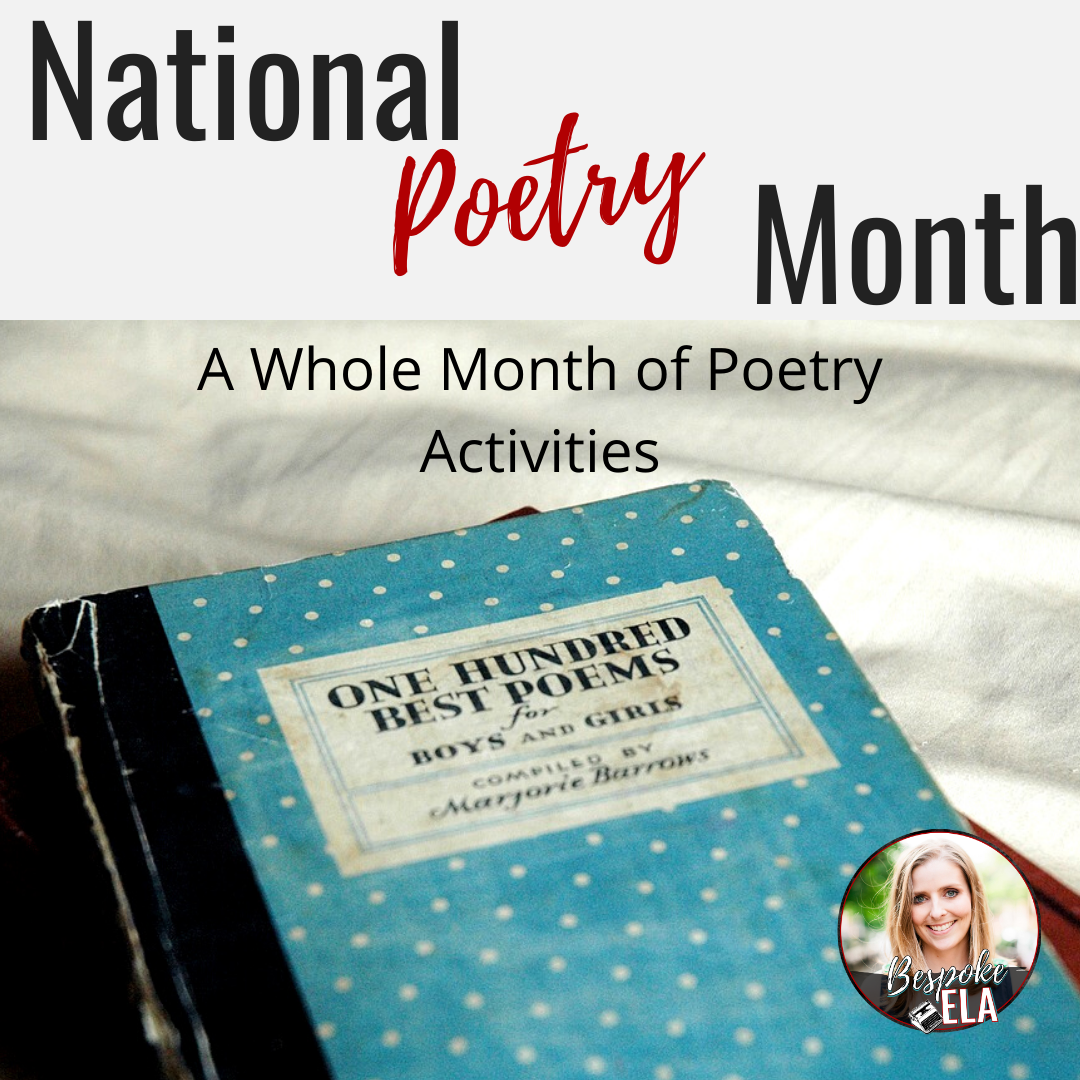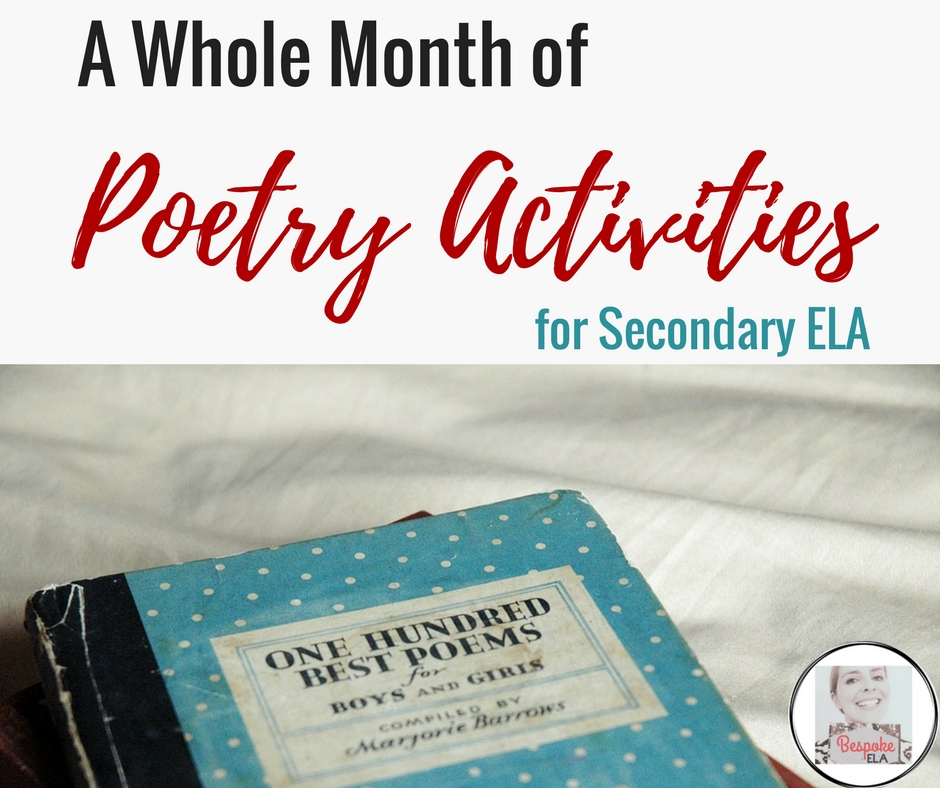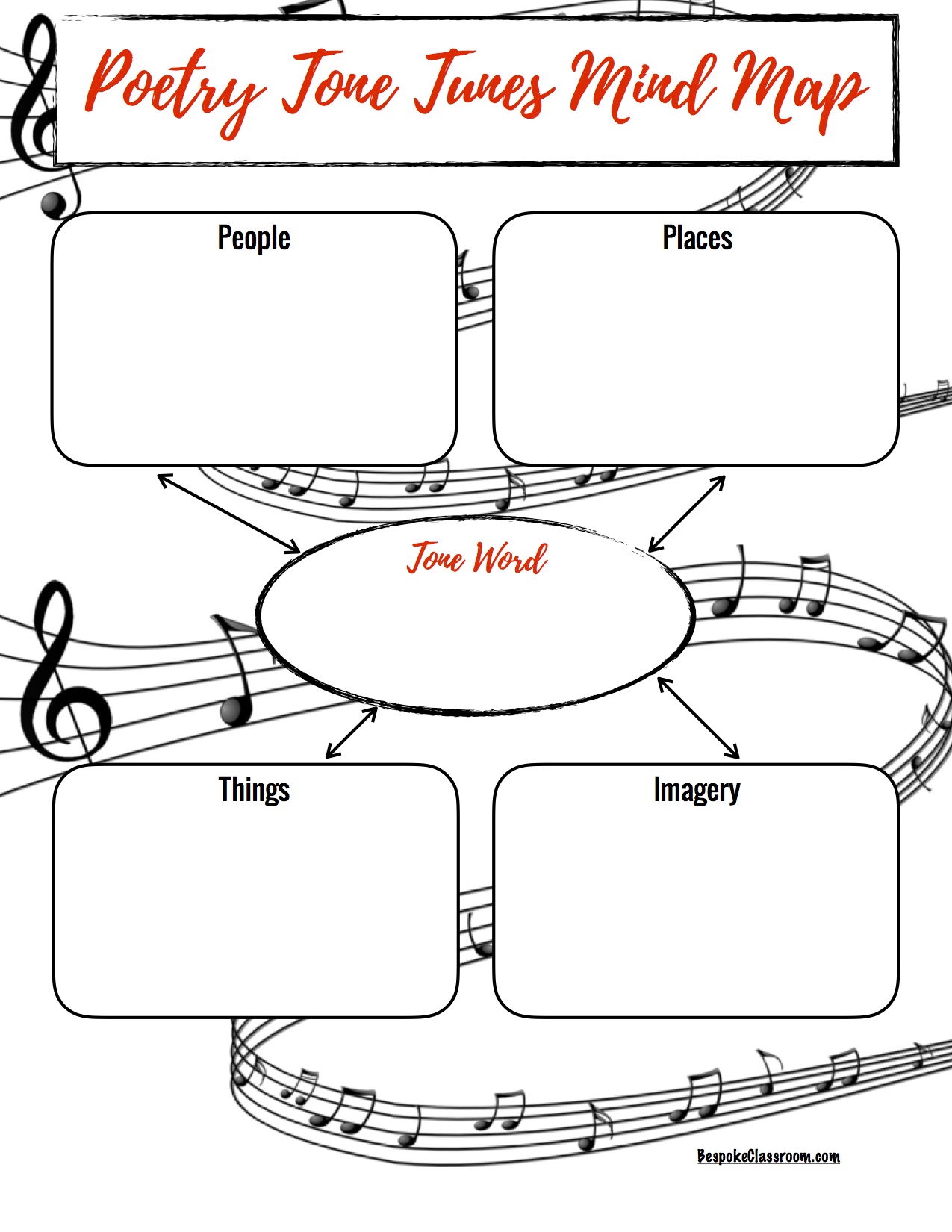Love it or hate it, poetry is unavoidable in the secondary ELA classroom. I, for one, am a HUGE lover of poetry but fully acknowledge that it can be annoyingly cryptic at times. Reading poetry reminds us that not all texts are meant to be beat "with a hose to find out what [they] really mean" like in the Billy Collins poem "Introduction to Poetry." Sometimes, a poem is literally a free association of words that plays with sounds and ideas but collectively yields utter nonsense-- tell THAT to the folks who write standardized tests! HA! I am convinced that standardized testing is what spoils poetry for students and teachers. When we can set those things aside, we can fall in love with words and sounds and images-- apart from trying to select the "correct" multiple choice answer.
I find that getting students to buy into poetry means getting them to WRITE POETRY! When they become the poets, they get to express their own ideas and emotions. Any time students can write about what they care about, their motivation + efficacy increases. Each year during National Poetry Month, I turn my classroom into a coffee shop, and my students write poetry, read poetry, and share poetry. At the end of the month, we host a poetry slam, and students select one of the poems they've written to share with the entire class. We dim the lights, we set the stage, we have refreshments, we have background coffee shop music... the whole thing. Students LOVE IT!
Poetry Activities + Lessons
Here are the activities prompts you will find on the calendar this month! Follow Bespoke ELA on Instagram HERE to learn about these poetry activities throughout the month of April!
Tone Tunes
Check out my post for TeachWriting.org here to read all about Tone Tunes! The purpose of this activity is to practice using tone to create a thematic message. Students will listen to instrumental music and determine the tone of the music. Then, they will brainstorm images they associate with that tone and use those images to write poetry. There are many ways to differentiate this activity such as having students brainstorm parts of speech (adjectives, adverbs, verbs, nouns, etc.) or even literary devices (similes, metaphors, allusion, etc.) that they associate with the tone and then use those words to inspire a new poem. The final step in the tone tunes lesson is to explicate the poem and explain how it uses tone to create theme.
Zip Ode
A zip ode is a poem that uses your zip code to inspire a poem about where you live. In this activity, students write a 5-line poem (one line for each digit of the zip code) about their cities. For each line, the digit from the zip code determines the number of words in each line. For the digit "zero," you are free to select how many words you want for that particular line.
Exquisite Corpse Poem
The Exquisite Corpse Poem is a collaborative poem activity that was created during the Parisian Surrealist Movement of the 1920s. In this poetry game, students get into groups and decide upon a grammatical pattern using parts of speech for each line of poetry such as "Adjective Noun Verb Adjective Noun." Students can try any combination of words they like as they play rounds of this poetry game. Once students have decided upon a grammatical pattern, each member takes a piece of paper and writes down a word for the first part of speech from the grammatical pattern. In this example, students would all begin with an adjective. After writing down an adjective, students would pass their papers in a circle to the next group member who would then add the next word from the pattern. In this case, students would all add a noun, and so on. By the end of the rotation, each student will have an "Exquisite Corpse Poem" that may be total nonsense... or it might be profound. The name “Exquisite Corpse” comes from a line of poetry created using the technique: “The exquisite corpse will drink the young wine.” Click on the image above to download a FREE info sheet about Exquisite Corpse Poetry.
Blackout Poetry
Blackout poetry tends to be really popular among students. In essence, students take a page from a text and black out words, leaving uncovered words and phrases that can be combined to form a poem. Students can also create visual art on the page to accompany the poems they've created. This is a fun poetry activity to accompany any unit of study. Students can focus on select themes from the unit, or they can explore their own themes and turn them into works of art. After creating their blackout poems, students can explain how the visual illustration relates to the message of the poem. They can also explain their overall theme and how it is communicated through the words, or diction, of the poem.
Protest Poetry
There's no time like the present to give students an opportunity to protest against injustices in our society. As we have all witnessed through the tragedy of Marjory Stoneman Douglas in Parkland, Florida, students are capable of changing the world. Share sample protest poems + songs with students such as "Caged Bird" by Maya Angelou, "I Look at the World" by Langston Hughes, and "Riot" by Gwendolyn Brooks, and give students an opportunity to select an issue and speak their minds through poetry for change. Have your students listen to this NPR interview to learn more about how poetry can be used as protest. In this interview, Morning Edition co-host Rachel Martin talks to authors Kwame Alexander and Nikki Giovanni about protesting through poetry.
Poem for Two Voices
A poem for two voices is a poem that is written with two (or more) speakers. The speakers may share similar or differing viewpoints or attitudes on the topic of the poem. The two speakers may speak at the exact same time or in tandem. Check out the book Joyful Noise for sample poems. Then, pair up your students and have them create their own poems for two voices to perform for the class. Students always have fun with these poems. Use them as a way to explore different perspectives on key issues or topics such as gun control, racism, police brutality, standardized testing, etc.
Lift a Line Poem
This poetry exercise literally does what it's called-- students lift a line from another text and start a new poem with that line. This is also an exercise to use for writing prose, memoirs, or even essays. These lines can come from any source but consider having students lift a line from a unit of study. Consider using the lift a line technique as a bell-ringer or quick write at the beginning of the class period.
Cut in Half Revision
For this revision exercise, students are to select one of their poems and count the number of words. Then, they are to literally cut the poem in half by deleting HALF OF THE WORDS and revise the remaining words so that they communicate the same idea as the original poem. This revision activity forces the writer to be very selective about each word + phrase. With this revision exercise, there is no "room" for a wasted word. Students will have to think very carefully about each word and revise the poem as needed.
Instagram Poem
Students love social media, and they love Instagram! For this poetry activity, students are to take their poetry writing out into the world of social media. Here's how it works! Have students find a captivating photo on Instagram and write a poem as a comment to that photo... then see how people respond! They can choose any photo posted by anyone. Then, have students report back to class and share their poems along with the responses they received. Students usually find that people are receptive to their poems and appreciate them! While students are on Instagram, encourage them to research some Instagram poets! Here are some of my favorite IG poets: ChristinaKaylenHart , ChristopherPoindexter, and CubsthePoet.
Black Light Poetry
What student doesn't love to play with black lights? For this poetry activity, students write poems that can only be read using a black light. Have students use fluorescent markers to write their poems. Then, turn off the lights and have students use black light flashlights to read poems by their peers. Think of it as another way to create a secret message poem. Try out these miniature keychain black light flashlights with your students for this activity. They come in packs of ten, so students can take turns sharing them or work with a partner in class. Any time you can bring a novelty item to poetry, students are guaranteed to be more interested and more engaged!
New Word Poem
What do the words "Google," "muggle," "mashup," "staycation," and "selfie" have in common? They were ALL MADE UP WORDS! That's right! These words were NOT in the dictionary and did NOT exist until someone made them up! For this poetry activity, students are to create a brand new word of their own and then write a poem that illustrates the meaning of the word. Challenge students to get creative and "think outside the box" with this poetry activity! This is also a great activity to use for prose writing and also during a unit on context clues.
Phone Number Poem
A phone number poem is a type of "about me" poem in which students use their phone numbers to inspire a poem about who they are. For this activity, students write one line of poetry for each digit in their phone numbers (so ten lines total). Each digit in the phone number determines EITHER the number of syllables per line OR the number of words per line-- the choice is yours! For the digit "zero," students have a free choice and can choose however many syllables/words they'd like.
Fun-House Mirror Revision
For this revision activity, students are to revise a poem of their choice by "holding it up" to a fun-house mirror. In essence, students are to create a distorted, fantastical view of their poems. Think in terms of creating the Tim Burton, Alice in Wonderland, or Picasso version of of the poem to experiment with a new way of "seeing" the original poem. Students can compare/ contrast the two versions of the poem and then decide which one they like best.
Found Poem
There is a popular creative movement to make something new out of "found" objects, and this same concept can be applied to writing. To create a "found poem," students are to rummage through old magazines and newspapers and cut out words/ phrases that they like. Then, they are to take these words + phrases and arrange them to form a new poem. You can also have students include pictures to illustrate their poems to turn them into works of visual art. As an extension activity, have students write an explication paragraph on the back to explain the message they "found" through this activity.
Pop Sonnet
This activity assumes that students have prior knowledge and experience with Shakespearean sonnets. Students will first need to have a basic understanding of English sonnet form and Shakespeare's language. I would recommend this activity at the end of a Shakespearean sonnet unit.
The pop sonnet began as an internet sensation and went on to become a popular book. The author had the idea to "Shakespearify" modern pop songs and morph them into sonnets. The result? A whole new level of depth for (mostly) simple songs with simple themes. Shakespeare would have been proud because this was Shakespeare's process-- to take simple ideas such as love and give them more complexity and sophistication. In this activity, students will explore pop sonnets via the (now famous) pop sonnet blog where it all started. They will then set out to select their very own pop songs to morph into Shakespearean sonnets. Students may choose to do this activity in pairs-- depending upon the level of the class. After crafting their own pop sonnets, students will then answer a series of questions that takes them through explaining and analyzing their original poems. Consider having students publish their pop sonnets online (via individual or class blogs) along with the original song lyrics and their analyses. Another fun and interactive way for students to share their pop sonnets is to have a read aloud in which the class tries to guess the title of the original song that inspired the sonnet.
Crafting a Shakespearean sonnet can be quite tricky due to the rhyme scheme and meter. Consider having students try one or the other, not both. Another option would be to give students an assortment of pop sonnets from the blog and have them analyze one of those in lieu of writing their own sonnets.
Song Lyric Mashup
There are a couple of ways to do this poetry activity. I like to have my students select two of their favorite songs and cut up the lines, words, phrases and then rearrange them to form a new poem. In a way, students use the song lyrics to create a "found" poem. You can also have students complete this activity using only one song instead of two. Challenge students to create a message different from the original songs, or have students try to guess the original song that was used for the mashup. Students love music, so students love this poetry activity!
Poetry in Motion
Poetry in Motion is an organization that puts poetry in the transit systems across America. I discovered Poetry in Motion while riding the subway in New York City when I lived in Brooklyn. These poems always brought a smile to my face amongst the stress of being in a crowded train. Think about the kind of poem a commuter would like to read. The poem could be about commuting, the transit system, the subway, work/life balance, vacation, being human, etc. Then, craft a new poem and create a Poetry in Motion poster that could be placed in the transit system of a major city.
Imagist Revision
For this poetry revision activity, students are to observe poems written by the Imagists such as Ezra Pound and then revise one of their poems in the style of the Imagists. The Imagists were known for using specific, distinct images that painted a vivid and clear image in the reader's mind. This revision practice challenges students to use specific imagery in their writing and helps students replace vague, ambiguous, generic language with more visual details.
Opposites Poem
Paul McCartney once spoke about writing the song "Hello, Goodbye" as a writing exercise of using opposites to communicate an idea. Katy Perry also used the same technique in her song "Hot, Cold." So, for this poetry activity, students are to use opposites to communicate an overall theme. To begin, students should brainstorm as many opposite pairings as possible and then begin to arrange them to form meaning. The opposites poem also works for two voices, and students can write them in pairs and present the two voices + two perspectives to the class.
Invent a Form Poem
Invent a Form Poetry has always been a favorite of my students. In this activity, students are to think outside the box to create their own form of poetry. They need to write the rules for their new form as well as write an example poem of their form in action. I like to have my students take turns presenting their new forms of poetry to the class and have the class write poems using these new forms. Just be prepared because I've seen it all: Projectile Poetry (with items flying at the paper), Candy Poetry (using real candy), and Microscopic Poetry (so small it takes a magnifying glass to read). But overall, students get to express their creative muscles and share their ideas with the class.
Poetry Slam
At the end of a poetry unit, have your students hold a Poetry Slam (more in the style of a Poetry Festival). I like to set my classroom up like a coffee shop with dim lighting, background coffee shop sounds, and even snacks! Students select one of the poems they've written and share it with the class in a supportive, no pressure environment. By this point in the year, students are generally more comfortable sharing their writing since we've worked to build a writing community in the classroom. I prefer not to have students compete in class, but you could certainly make the poetry slam a class competition like Poetry Out Loud. There are lots of ways to host a poetry slam in your classes, and students really get to enjoy poetry apart from analysis.
What poetry activities do you love doing during National Poetry Month? We'd love to hear from you!
About the Author
Meredith is the founder and creator of TeachWriting.org and Bespoke ELA. She has taught high school English for 10+ years in Dallas, Chicago, and New York City and holds a M.A. in Literature from Northwestern University. She has always had a connection to the written word-- through songwriting, screenplay writing, and essay writing-- and she enjoys the process of teaching students how to express their ideas. Meredith enjoys life with her husband, daughter, and sweet pups.





















